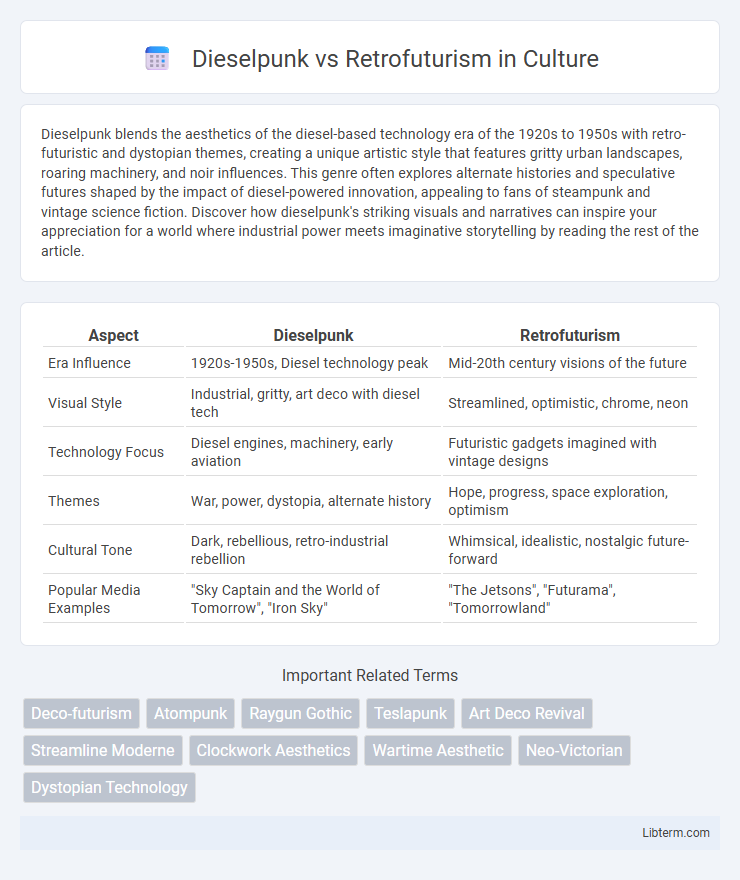Dieselpunk blends the aesthetics of the diesel-based technology era of the 1920s to 1950s with retro-futuristic and dystopian themes, creating a unique artistic style that features gritty urban landscapes, roaring machinery, and noir influences. This genre often explores alternate histories and speculative futures shaped by the impact of diesel-powered innovation, appealing to fans of steampunk and vintage science fiction. Discover how dieselpunk's striking visuals and narratives can inspire your appreciation for a world where industrial power meets imaginative storytelling by reading the rest of the article.
Table of Comparison
| Aspect | Dieselpunk | Retrofuturism |
|---|---|---|
| Era Influence | 1920s-1950s, Diesel technology peak | Mid-20th century visions of the future |
| Visual Style | Industrial, gritty, art deco with diesel tech | Streamlined, optimistic, chrome, neon |
| Technology Focus | Diesel engines, machinery, early aviation | Futuristic gadgets imagined with vintage designs |
| Themes | War, power, dystopia, alternate history | Hope, progress, space exploration, optimism |
| Cultural Tone | Dark, rebellious, retro-industrial rebellion | Whimsical, idealistic, nostalgic future-forward |
| Popular Media Examples | "Sky Captain and the World of Tomorrow", "Iron Sky" | "The Jetsons", "Futurama", "Tomorrowland" |
Introduction to Dieselpunk and Retrofuturism
Dieselpunk is a genre blending the aesthetics of the 1920s to 1950s with diesel-based technology and dystopian themes, often featuring industrial design, Art Deco, and wartime motifs. Retrofuturism envisions the future through the lens of past eras, combining vintage styles with futuristic technology imagined by previous generations, often reflecting optimism and speculative innovation. Both genres creatively reinterpret past technological eras but differ in tone, with Dieselpunk leaning towards gritty realism and Retrofuturism embracing stylized futurism influenced by historical optimism.
Defining Dieselpunk: Aesthetic and Origins
Dieselpunk is a subgenre of speculative fiction and design rooted in the aesthetics of the interwar period through the 1950s, blending the industrial design and technology of the diesel-based era with dystopian and noir elements. It draws heavily from World War I and II cultural influences, emphasizing machinery, gritty urban environments, and a bygone era's technological optimism mixed with decay. The style originates from early 2000s fandom as a reaction to steampunk, focusing on diesel technology and the sociopolitical tensions of the early 20th century rather than Victorian motifs.
Understanding Retrofuturism: Concepts and Influence
Retrofuturism explores futuristic visions inspired by past eras, blending nostalgia with speculative technology from the mid-20th century, influencing design, literature, and media. It often reimagines future possibilities through the aesthetic and cultural lenses of the 1920s to 1960s, emphasizing themes of optimism and innovation. This genre contrasts with Dieselpunk by presenting a broader, more optimistic vision of the future that extends beyond the industrial diesel era to incorporate diverse retro-styled futures.
Key Visual Differences Between Dieselpunk and Retrofuturism
Dieselpunk visuals emphasize gritty, industrial aesthetics with influences from the 1920s to 1950s, featuring heavy machinery, Art Deco architecture, and war-era technology. Retrofuturism often incorporates sleek, utopian designs inspired by mid-20th century visions of the future, with streamlined forms, bright colors, and imaginative space-age motifs. The contrast lies in Dieselpunk's darker, mechanical realism versus Retrofuturism's optimistic and stylized portrayal of future technology.
Core Themes and Motifs Explored
Dieselpunk explores themes of industrial power, war, and urban decay through motifs like diesel engines, Art Deco aesthetics, and military technology from the 1920s to 1950s. Retrofuturism imagines past visions of the future, blending nostalgia with futuristic technology, often featuring streamlined designs, ray guns, and optimistic space exploration inspired by mid-20th-century ideals. Both genres reflect cultural attitudes toward progress and technology but emphasize different eras and technological visions in their core motifs.
Influences from History and Technology
Dieselpunk draws heavily from the interwar period and World War II era, incorporating technology inspired by diesel engines, industrial machinery, and the aesthetics of 1920s to 1950s society. Retrofuturism reflects past visions of the future, often influenced by mid-20th-century space age technology, atomic energy, and early computing concepts from the 1950s to 1970s. Both genres explore alternate histories through distinct technological advancements, with Dieselpunk emphasizing gritty, mechanical innovation and Retrofuturism focusing on optimistic, streamlined designs.
Iconic Examples in Media and Literature
Dieselpunk is exemplified by media such as the film "Sky Captain and the World of Tomorrow" and the video game "Bioshock Infinite," featuring industrial 1920s-1940s aesthetics fused with advanced technology. Retrofuturism appears prominently in literature like Philip K. Dick's "The Man in the High Castle" and films including "Brazil," showcasing futuristic visions inspired by past eras' design and culture. Both genres emphasize alternate histories and technological fantasy, but Dieselpunk leans toward darker, war-influenced themes, while Retrofuturism often reflects optimistic or critical takes on past futurism.
Community and Subculture Perspectives
Dieselpunk communities emphasize gritty industrial aesthetics inspired by 1920s-1950s history, fostering subcultures that celebrate noir, wartime innovation, and diesel technology. Retrofuturism subcultures prioritize optimistic visions of the future from mid-20th-century perspectives, blending vintage design with speculative sci-fi themes. Both communities engage through cosplay, fan art, and conventions, yet dieselpunk leans toward dystopian realism while retrofuturism embraces imaginative optimism.
Crossover Elements and Shared Inspirations
Dieselpunk and Retrofuturism both draw heavily from early-to-mid 20th-century aesthetics, blending industrial design with speculative technology. They share inspirations such as Art Deco motifs, neon lighting, and a fascination with the promises and anxieties of rapid technological advancement during the interwar and postwar eras. The crossover elements emerge in their emphasis on mechanical innovation, streamlined forms, and a nostalgic yet imaginative reinterpretation of past visions of the future.
Dieselpunk vs Retrofuturism: Future Trends and Evolving Styles
Dieselpunk emphasizes a gritty, industrial aesthetic rooted in the interwar period, blending diesel technology with noir and wartime motifs, while Retrofuturism explores optimistic, imaginative visions of the future inspired by mid-20th-century design. Future trends in Dieselpunk are evolving toward darker narratives and immersive virtual realities, incorporating diesel-powered machinery fused with cyberpunk elements. In contrast, Retrofuturism is expanding its stylistic range by integrating sleek, streamlined designs with sustainable technology themes and vibrant neon color palettes, reflecting evolving cultural hopes about the future.
Dieselpunk Infographic

 libterm.com
libterm.com